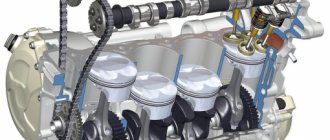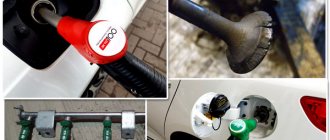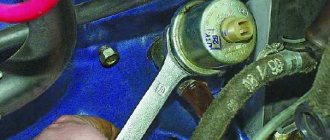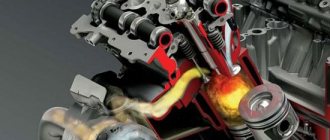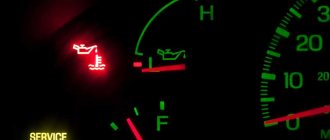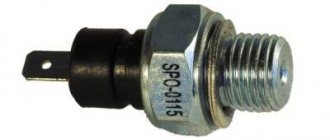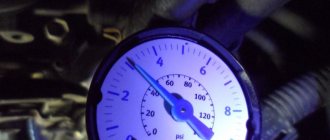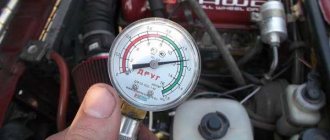01/26/2022 7,764 VAZ 2106
Author: Ivan Baranov
During the operation of a car, sometimes it becomes necessary to measure the compression in the engine cylinders. Typically, such a need arises during diagnostics if there is a suspicion of a malfunction of the piston group. The article discusses what the VAZ 2106 compression is and how it is measured.
[Hide]
How and what to measure
Compression is measured with a special device - a compression meter.
It is a pressure gauge with a hose, at the end of which there is a fitting, either metal with a thread for a spark plug hole, or rubber in the form of a cone. The process of measuring compression using a compression gauge involves placing a fitting in the spark plug hole and cranking the crankshaft with the starter until maximum pressure is reached.
Compression in a cylinder can also not be measured, but checked and compared with other cylinders.
To do this, unscrew all the spark plugs except one, and manually (using a wrench on the generator pulley nut) turn the crankshaft until the piston reaches top dead center.
Then they check the second cylinder, the third and the fourth in the same way, and compare the applied forces. Of course, this method is not comparable to measuring with a compression gauge, but it can help to understand which cylinder has a problem.
What should the compression be in VAZ cars?
The average compression rate for unboosted VAZ engines is 8-9 atmospheres, for forced ones with a reduced combustion chamber - 11-13 atmospheres.
In order to accurately determine the standard compression ratio, use the table that indicates the compression ratio in the cylinders of eight- and sixteen-valve VAZ engines.
https://zarulemvaz.ru/kompressiya-v-dvigatele-vaz-2107-i-sposoby-ee-izmereniya/https://provaz07.ru/dvigatel/kompressiya-v-vaz-2107.htmlhttps://automn. ru/vaz-2107/vaz-16633-10.m_id-713.m_id2-1656.htmlhttps://znatokvaz.ru/dvigatel/kompressiya-dvigatelya-i-proverkahttps://mylada.net/nachinayushhemu-avtomexaniku/kak- proverit-kompressiyu-dvigatelya.html
How to Complete a Compression Test in Under 30 Minutes
Engine Cylinder Compression Testing Guide
A car engine needs cylinder compression to run properly. this compression is caused by the movement of the engine pistons up to the top of the cylinder bore and then down through the crankshaft. When engine compression is low in any particular cylinder the cause is misfire, which can cause a check engine. When there is no compression across all cylinders the engine will not start, for example when the timing belt or chain breaks.
Compression Test Costs
When performing a compression test at a repair shop, the cost will vary depending on how many cylinders your vehicle's engine has and how difficult the spark plugs must be removed. Most shops will charge around $80.00 for 4 cylinders and around $140.00 (US) for V8 engines. If you do the job yourself with the help of this guide, the caliber will cost you $17.00 and $30.00 Amazon depending on the quality and adapters included.
If you just need to know if the engine has compression at all, in another word the engine is not running and you want to check if any of the cylinders have compression you can do this with a simple paper towel, which we will show you later in this manual.
Let's start!
The engine should be warm, but not hot, to avoid getting burned. Some mechanics like to test with the engine running at operating temperature, but this makes little difference in a modern engine. You will need a spark plug and a compression sensor. It's a good idea to wear gloves and safety glasses as well. If you are checking the compression of one specific cylinder, remove the fuel pump fuse to disable engine starting. This will also keep fuel from entering the cylinder, which will prevent a fire from occurring while all spark plugs are removed. You may not be able to find the fuel pump fuse by checking the fuse panel or owner's manual.
1. Remove all spark plug or ignition coil wires:
Remove the spark plug or ignition coil wires from each cylinder. Use a small piece of tape to mark the plugs so you don't mix them up when installing them.
2. Remove the spark plugs:
Use a ratchet and a spark plug extender to break out and remove everything from the spark plugs. When removing the spark plugs, keep them in the order of the cylinder where they are removed. This will help in inspecting the plugs if a problem with cylinder compression is found.
3. Insert the compression hose:
The gauge will have a rubber hose attached to a metal fitting threaded to match the spark plug. This will allow the hose to thread into the spark plug hole. Tighten the hose by hand until it presses against the O-ring on the sensor hose.
4. Attach the pressure sensor:
The sensor will be equipped with a connector that will attach to the pressure sensor hose. Lift the connector ring and push down on the hose. You should feel a firm connection between the test hose and the spark plug hose. Some sensors do not have a separate hose and screw directly into the spark plug hole.
5. Crank the engine through:
If you are only testing one cylinder, be sure to pull the fuel pump fuse to prevent the engine from starting. On older engines you can remove the coil wire. All compression tests must be done at normal engine speed. Insert the ignition key and crank the engine for more than 10 seconds. This should give the sensor enough time to gather the correct cylinder combustion pressure.
6. Observe the compression sensor:
The gauge will begin to rise on the first rotation of the engine and continue to rise until maximum pressure is reached, which should be marked down. Typical compression readings will be between 125 and 160 psi.
7. Remove the pressure gauge:
After the test, remove the pressure gauge by unscrewing the test lead from the cylinder.
8. Reinstall the spark plug:
Check the spark plug for damage and then carefully install it back into the cylinder and torque it to factory specifications which is usually 15 to 20 pounds.
9. Reinstall the coil or plug:
Carefully place the coil or plug back into place while pressing firmly on the spark plug terminal. Continue checking each cylinder in the same way. All cylinders must be within 5% of each other. If you observe a cylinder that has low compression, there is a problem. Press the pressure release valve on the side of the pressure gauge, which will return the pressure gauge to zero pressure for the next test.
Cylinder compression can tell you how much engine wear is occurring. A compression test can also report a separate cylinder problem that can be repaired. Engine Symptoms of low compression may include: burnt intake or exhaust valves, a broken piston or piston rings, a broken valve spring, or a blown head gasket. If you find a cylinder with low compression, add a small amount of engine oil. into the cylinder and retest compression. If the compression is higher than you know it is a problem with the piston rings because the oil will temporarily seal the rings to the cylinder wall. Here's what a typical compression sensor set looks like:
Watch the video!
In this video we do a test using a sensor that measures the amount of compression in a single cylinder.
Watch the video!
In this video we check to see if the engine has compression. The belt or chain is broken. This test can be performed without using a sensor.
Examination
Now you can proceed directly to the verification.
- Warm up the engine until it reaches operating temperature, then turn off the ignition.
- Turn off the fuel pump. If it is a mechanical pump, the tubes are disconnected and the fuel supply is cut off. In the case of an electric fuel pump, simply turn off the fuel supply relay and remove the fuse.
- Relieve the pressure that is inside the fuel system.
- Start the engine. This way the engine will be able to use up all the fuel that remains in the system. Wait until the engine comes to a complete stop.
- Now we continue to measure the compression.
- Disconnect the ignition module.
- Disconnect the spark plugs from the high-voltage circuits, then use a special spark plug wrench to unscrew them from their sockets.
- Insert a measuring device into the spark plug socket. On each cylinder, that is, when connecting the device to each hole, measurements are taken separately.
- Invite an assistant. His job is to sit in the driver's seat and press the gas pedal to open the throttle.
- At the same time, the engine starts for 5-10 seconds.
- At this moment you are taking readings from the measuring device.
- Using a similar method, you should take measurements on each cylinder, resetting the readings of the previous one on the device. Record your findings.
For VAZ 2110 engines, the normal compression indicator is 10 bar or 1.0 MPa on any cylinder. A difference between the indicators is allowed up to 1 bar or 0.1 MPa, that is, normal data is 11-11-11-11 or 10-11-11-10 and similar test results. If you deviate from them, you should look for the causes of the problem.
Video “Measuring compression in cylinders of a VAZ 2106”
This video demonstrates how to properly measure blood pressure.
An engine malfunction, even the smallest one, is always serious. And then, when you suddenly feel that fuel and oil consumption has increased, the performance of the most important unit of your car has decreased, at this moment it is worth taking care of diagnosing the engine cylinders, which most likely have stopped working in their normal mode. But compared to in-place diagnostics, disassembling the engine into parts and thus checking its condition is still more effective. Experienced car enthusiasts often prefer not to resort to the services of service stations, but rather repair feasible breakdowns on their own. The same is true with diagnostics of the cylinder-piston group of engine mechanisms; it can be carried out on your own. To do this, you need to use a special device, a compression meter, which is similar in appearance to a pressure gauge.
Experts recommend purchasing for personal use a device with a threaded tip so that the compression gauge is screwed into a special hole in the spark plug, rather than pressed into it, then its readings will be more accurate. Compression is the degree of gas compression under the pressure of external forces in the cylinder. Normal engine compression is calculated approximately as the compression ratio multiplied by 1.3. So, measuring engine compression allows you to detect a cylinder that is malfunctioning.
A decrease in pressure in the cylinder is associated with its leakage, which can occur for several reasons: clearances in the valves. First of all, make sure that the valve clearances are in place. If necessary, adjust them to the correct position. Warm up the engine to a temperature of 70-90 degrees. For correct diagnosis, the unit must be warm.
At the same time, limit the flow of fuel to the mechanisms you are diagnosing, for example, disconnect the fuel pump. Next, unscrew all the candles and place them in a dry, clean place for a while. In order not to forget which spark plugs are connected to high-voltage wires, make some notes on the caps. Open the air valve and throttle. Insert the tip of the compression gauge into the corresponding passage of the spark plug, and use the starter to turn the motor shaft until the pressure in the mechanism stops increasing. Monitor the crankshaft speed, it must be at least 190-200 revolutions per minute.
Checking engine compression is carried out provided that the battery is fully charged and the starter is working properly. With a properly functioning engine, the pressure rises in seconds, but if you observe a slow increase in compression, this indicates wear of the piston rings, or their combustion. If the pressure does not rise at all, then the cylinder head gaskets may be worn out. The minimum compression level is acceptable at 10 kg/cm.
How to measure engine compression?
Required Tools
To take measurements of the VAZ 2106 you need to prepare:
- compression gauge;
- spark plug key;
- instructions for the engine installed on the VAZ 2106.
Compression gauge with a set of adapters
The compression gauge should be selected with a threaded tip so that it is screwed into the spark plug hole and not pressed in. In this case, more accurate values will be obtained. You also need to check that the valve that records the readings is located in the pressure gauge head, which is screwed into the hole for the spark plugs, and is not located under the measuring device. This will make it possible to avoid underestimating pressure readings during diagnosis. The compression tester kit includes adapters that allow diagnostics on any engine.
It is better to carry out diagnostics with an assistant: one person screws or holds the tip of the device, the other presses the gas pedal as much as possible and starts the starter.
Stages
The test is performed with the engine warmed up to a temperature of 70-90 degrees. Before diagnosing, turn off the fuel supply. If a mechanical fuel pump is installed, then you need to disconnect the fuel line through which fuel is supplied. In the case of an electric fuel pump, you need to de-energize its relay. The battery must be fully charged. Measuring pressure in a VAZ 2106 consists of the following steps:
- First, you should clean the niches where the spark plugs are located and disconnect the high-voltage wires.
- Then you need to unscrew all the spark plugs.
Broken spark plug
- The gear lever must be in neutral position.
- Now you need to disconnect the central wire from the ignition coil in order to de-energize the car while the starter is running.
- Then you should screw the tip of the compression gauge into the spark plug hole.
- After starting the starter, you need to turn the ignition key until the readings on the pressure gauge stop increasing, usually 4 compression strokes are enough.
- Readings should be taken one by one in each cylinder, resetting after each measurement.
Alternate readings
Diagnosis of the VAZ 2106 should be performed with the throttle valve open and closed. In each case, this makes it possible to identify your defects.
When diagnosing, you need to pay attention not only to pressure, but to the difference in compression values of different cylinders. The readings between them should not exceed 0.5 - 1 atmosphere. This will make it possible to determine which cylinder is causing the problem. Thus, any car enthusiast can make diagnostics on a VAZ 2106 by measuring the pressure in the cylinders. It is enough to have a compression gauge and an engine maintenance manual. Based on the inspection, you can draw conclusions about malfunctions and carry out repairs, if possible at home.
Recovery methods
To increase the compression in the engine, if you are sure or suspect that the rings are stuck, you can pour 100 grams of clean oil into each and give them time to “throw away”. Sometimes turning the crankshaft in both directions a few degrees. The procedure can be repeated.
The second, more effective method, you need to take: 1 part clean motor oil, 1 part acetone and 1 part kerosene. Stir and pour 50 ml into each cylinder, tighten the spark plugs and leave for 10 hours. Unscrew the spark plugs and crank the engine with the starter for a few seconds. We install the spark plugs, start it and heat it up to 40 degrees no more. Drain the oil, flush the system, change the filter and fill in new oil.
There are also special means that are also used to combat increased compression, which occurs when there is more carbon deposits on the piston and in the combustion chamber.
The second method is to restore pressure by adding additives to the oil. There are quite a lot of them on the market with varying effectiveness. I wrote about the use of the Suprotek additive, the effect of its use is positive.
Characteristics of oils for VAZ
The service life of the engine depends on the correct selection of oil for injection VAZ 2107. The recommended quality standard for the lubricating fluid is given by the manufacturer. Any type of oil that meets API SJ/CF, SG/CD quality standards can be filled into the car.
The abbreviation API means that a lubricant meets the following basic criteria:
- cleaning properties;
- temperature regime;
- indicator of deposits on engine components before the first oil change;
- release of harmful substances;
- corrosive properties;
- effectiveness of protecting components from friction.
It is recommended to use the following types of oils.
| Oil brand for VAZ | SAE viscosity groups | API standard |
| RAVENOL LLO | 10W-40 | SJ/CF |
| SHELL HELIX SUPER | 10W-40 | SG/CD |
| TNK SUPER OIL | 5W-40, 10W-40, 15W-40, 20W-40 | SG/CD |
| TOTAL QUARTZ | 5W-40, 10W-40 | SL/SF |
| MOBIL SUPER M | 15W-40 | SJ/CF |
| LUKOIL LUX | 5W-40, 10W-40, 15W-40 | SJ/CF-4 |
| NOVOIL-SINT | 5W30 | SG/CD |
| CONSOL | 5W-40, 10W-40, 15W-40 | SG/CD |
| BIZOL GREEN OIL | 10W-40 | SL/SF |
| ESSO ULTRA | 10W-40 | SJ/CD |
| LUKOIL SUPER | 5W-40, 10W-40, 15W-40, 10W-30 | CF-4/SG |
| RAVENOL SUPER HD | 15W-40 | SJ/CF |
| LUKOIL SUPER | 5W-30, 5W-40, 10W-40, 15W-40 | SG/CD |
| ANGROL-SUPER | 5W30, 5W-40, 10W-40 | SG/CD |
| LUX | 5W30, 5W-40,10W-30, 10W-40, 15W-40, 20W-40 | SG/CD |
| ESSO UNIFLO | 10W-40, 15W-40 | SJ/CD |
How to correctly measure compression in Lada car engine cylinders
How to quickly and accurately determine the condition of the engine? Check the compression in the cylinders! Is the engine running rough, you feel a loss of power, the consumption of engine oil or fuel has increased and the car has become difficult to start in cold weather? All of these problems may be caused by low compression in one or more cylinders.
How to measure compression in cylinders
A device for checking compression in cylinders is called a compression gauge. There are many varieties of them, but the differences between them are only constructive. Great for self-diagnosis.
At service stations you can find more complex devices that use a recorder instead of a dial pressure gauge that records the compression on a form or display.
To ensure that the compression test gives accurate results
Compression depends not only on the technical condition of the engine, but also on the conditions under which it is measured. Make sure that during the check:
- the compression gauge was working properly;
- the engine has been warmed up to operating temperature (up to 90 degrees);
- the throttle valve was fully open;
- spark plugs in all cylinders must be turned out;
- the starter was fully operational;
- the battery was fully charged;
- The engine air filter was clean.
Procedure for checking compression in cylinders
- Remove the ECU fuse or wire from the ignition coil;
- Screw the compression gauge into the spark plug hole;
- The throttle valve is fully opened (press the gas pedal all the way);
- Turn on the starter for 5-10 seconds so that it turns the crankshaft;
- Check the compression gauge readings;
- Repeat steps 2-5 for other cylinders.
How to measure compression in cylinders on video:
What are the cylinder compression standards for VAZ engines?
Engine specifications must indicate “minimum cylinder compression values.” If you cannot find such data, determine the compression standards yourself using the formula:
| Compression (kgf/cm2) = compression ratio (see technical specifications of internal combustion engine) * coefficient (for VAZ min 1.2, max 1.3) |
- The compression ratio of modern VAZ 21126 and VAZ 21127 engines installed on Granta, Kalina and Priora is 11. We multiply the values using the formula and get the compression standards: 13.2..14.3.
- For the Vesta engine (VAZ-21129) the compression ratio is 10.45, the compression standards will be: 12.5..13.6.
- For Niva (VAZ 21213, 21314) - 11.3..12.2.
If the compression gauge values in all cylinders are within the normal range, this does not mean that everything is fine. Different compression in the cylinders is also bad
It is important that the difference between all readings is minimal. Compare the minimum and maximum compression values in the cylinders
According to technical standards, the difference should be no more than 1 kgf/cm2 or 10%.
Reasons why there is no compression in the cylinder
Poor (small) compression in one or all cylinders indicates engine wear. There is an old and simple way to determine why compression has disappeared. You need to pour a tablespoon of engine oil into the spark plug hole and repeat the measurements:
- if the pressure has increased noticeably, it means the piston rings have poor sealing;
- if the pressure has not changed, then there may be several reasons (for example, leaking valves, broken gaskets under the cylinder head, there is a crack or burnout in the walls of the combustion chamber, in the piston bottom).
There is another, more accurate way to find out why compression has disappeared. To do this, you will need to modify the spark plug. We remove the insulator from it, and weld the valve of the car camera to the metal body. Next, set the cylinder piston to the ignition timing position, remove the radiator caps and oil filler neck, screw in the manufactured adapter and pump air into the cylinder using a pump (create pressure in it):
- if air enters the exhaust pipe, it means the exhaust valve is poorly sealed;
- If air goes into the intake manifold, there is a problem with the intake valve.
- if bubbles appear in the expansion tank, then check the cylinder head gasket;
- If there is a hissing sound in the oil filler neck, it means that the piston rings are not properly sealed.
Engine diagnostics using compression measurements in the cylinders allows you to quickly and accurately determine its condition without disassembling, and in some cases will help avoid major repairs of the power unit. Have you ever experienced a lack of pressure in the cylinders? What was the cause of the malfunction? If engine problems persist, check the fuel rail pressure.
Compression rate
The compression (pressure) indicator plays an important role in detecting faults in the VAZ 2106 engine without disassembling it. The word compression in Latin means compression. Compression refers to the pressure in the cylinders at the extreme point of the compression stroke. A significant decrease in pressure indicates wear on the piston rings of the cylinders, as well as the cylinders themselves. If the valve clearances are incorrectly adjusted, the required amount of air does not enter the combustion chamber.
If compression is low, engine response decreases and fuel and oil consumption increases. With low cylinder pressure, engine power drops and the car cannot reach maximum speed. What compression is needed is indicated in special manuals for measuring it. The average compression rate for a gasoline engine is 9.5 - 10 atmospheres. In this case, the difference between the pressures in each of the cylinders should not exceed 10%.
Engine compartment of VAZ 2106
The following factors may affect the maximum cylinder pressure:
- degree of throttle valve openness: the less it is closed, the greater the pressure;
- Air filter contamination;
- incorrectly set valve timing;
- incorrectly adjusted valve clearances;
- motor temperature;
- wear of parts sealing the combustion chamber causes air leakage, which reduces pressure;
- the entry of oil into the combustion chamber acts as a seal, which increases the compression value;
- lack of tightness of the check valve or compressometer hose.
Diagnostics are performed when engine power decreases and when repairing the cylinder head or overhauling the cylinder block.
2.4. Compression check
Checking the condition of the engine can be done by measuring the compression in the engine cylinders. If this check is carried out regularly, then you can find out in advance the beginning of engine wear, without waiting for the moment when wear manifests itself in low engine efficiency.
Warm up the engine to operating temperature. In this case, the battery must be fully charged. Remove the spark plugs.
Disconnect the ignition system by disconnecting the low voltage supply wire (+ 15) from the ignition coil.
Install a compression gauge into the spark plug hole of the first cylinder.
An assistant must press the accelerator pedal all the way and crank the engine with the starter. After turning the crankshaft one or two revolutions, the compression pressure should increase to a maximum and then stabilize. Record the maximum result obtained.
Check the compression in the remaining cylinders in the same way.
Compression in all cylinders should not differ by more than 1.0 bar
Please note that the compression value should increase quickly on a healthy engine. Low compression on the first revolution of the crankshaft, accompanied by a gradual increase in pressure on subsequent revolutions of the crankshaft, indicates wear of the piston rings
Low compression on the first revolution of the crankshaft, which increases slightly thereafter, indicates a loose valve fit, a broken cylinder head gasket or a crack in the cylinder head. Worn valve stem ends can also cause low compression.
If the compression in one cylinder is low, then perform the following test. Pour some engine oil through the spark plug hole into the cylinder and check the compression.
If pouring oil into the cylinder increases compression, this indicates that the cylinder or piston rings are worn.
Low compression in two adjacent cylinders indicates a burnt gasket between the cylinders.
If the compression in one cylinder is 20% less than the others and the engine idles rough, this indicates a worn camshaft cam.
If the compression pressure is too high, this indicates that the combustion chamber is coated with a thick layer of carbon deposits.
After this check, screw in the spark plugs and connect the wire to the ignition coil.
What compression should the engine have?
What are the standards for compression ratios and compression ratios for internal combustion engines? They are different. The compression ratio of a gasoline engine can vary from 10:1 to 13:1, 14:1, or even higher. The compression of a diesel engine is never lower than 20:1. Textbooks on automobile theory and all kinds of manuals define the compression ratio as: “... the ratio of the total volume of the cylinder to the volume of the combustion chamber. The compression ratio is determined using the following formula (V + C)/C = CR, where V is the working volume of the cylinder, and C is the volume of the combustion chamber."
There are no formulas for calculating compression, since this value is no longer a calculated geometric value, but an absolute one. This, as mentioned above, is pressure. Compression depends on many factors, the main one of which is the quality of the tightness of the mating pairs - cylinder-piston, cylinder-valves, cylinder-throttle valve, etc.
Analysis of compression measurement results
Depending on the results of compression measurements, conclusions and recommendations for engine repair follow. A general and uniform drop in compression in all engine cylinders indicates uniform natural wear of the parts of the cylinder-piston group and the engine as a whole.
If the compression of one cylinder differs significantly from the compression of the others, then special attention should be paid to this unit. Leaks in the cylinder may be caused, for example, by a burnt-out valve, in which case disassembly, grinding in, or replacement of the valves is required. A leak may be caused by sagging piston rings. In these cases, mechanics say “the rings are stuck.” A drop in pressure can be caused by a burnt-out gasket between the cylinder block and the engine cylinder head. And in this case, not only a drop in compression is possible, but also coolant getting into the lubrication system and, conversely, oil getting into the cooling system.
The concept of compression, its measurements
There is no such characteristic among the technical data specified in the vehicle’s operating manual. There is a slightly different concept - compression ratio. There is no direct relationship between these two parameters; they are united by only one thing - in both cases we are talking about pressure.
- The compression ratio is a calculated constant value; it has no dimensional units. For the VAZ 2106 engine and its modifications it is 8.5. This figure is the result of dividing the total working volume of the cylinder by the volume of the combustion chamber. In simple words, the air-fuel mixture entering the cylinder space is compressed 8.5 times by the upward moving piston.
- Compression is a variable value; its value depends on the technical condition in which the engine is located. This parameter shows what pressure occurs in each individual cylinder when the crankshaft rotates using the starter. It is measured with a pressure gauge, which is screwed in instead of a spark plug, the unit of measurement is 1 kgf/cm2 or 1 Bar, which is almost the same (1 kgf/cm2 is equal to 0.98 Bar).
Compression is measured to determine the degree of wear of the cylinder-piston group. Its values were obtained experimentally, in practice. The measurement is performed as follows: all 4 spark plugs are unscrewed, and in their place, a pressure gauge with a check valve is screwed into each cylinder one by one, and by rotating the starter, the maximum pressure that can be pumped by each piston is determined. In the VAZ 2106 engine, the ideal figure is 13 kgf/cm2, but this is a rare case; such pressure is found on new, only run-in engines.
Measuring cylinder pressure without a compression gauge
Some motorists are wondering whether it is possible to check whether the compression in a VAZ 2114 8-valve engine is normal or not, without using special instruments.
The answer is yes. True, the results of such a measurement will not be accurate, but relative.
In order to check the condition of the cylinders without a compression gauge, you will need to remove all the spark plugs from the cylinders except one, which will be tested. Then you should manually turn the crankshaft. Then repeat a similar operation with the remaining three cylinders. Subjective sensations about the ease of rotation will be the result.
If, when testing one of the cylinders, the crankshaft rotates too easily, then this cylinder has reduced compression and significant wear. This can be confirmed or refuted by injecting a small amount of oil into the cylinder using a syringe.
If after this you have to rotate the crankshaft with significantly greater force, it means that the walls of the cylinder or piston have significant wear (since the oil has filled the gap and increased compression).
You can try to solve the compression problem on your own using one of the following methods: adjust the valves, decarbonize the engine (this will help remove carbon deposits that have settled on the walls) or replace the oil rings with new ones. If all these operations did not help, and the compression is still not up to standard, then the engine is seriously worn out and must be overhauled.
WHAT TO DO IF YOU DO NOT HAVE A COMPRESSOMETER AT HAND?
Is it possible to measure compression without a device? Practice shows that yes, it is possible. But this method will give relative and approximate readings. To measure the compression indicator without instruments, remove the spark plugs from all cylinders except the one being tested. Manually rotate the crankshaft until the compression stroke ends (watch the marks - they should match). Perform this operation on all cylinders one by one. Where the pressure is low, it will take less effort to turn the crankshaft. In this way, of course, you will not get accurate compression readings in the engine. But it is possible to understand the presence of problems.
Compression and compression, what's the difference?
In everyday life, when we talk and say compression, we mean compression; in reality, they are not the same thing. So what is the difference between compression ratio and compression?
The most obvious way to prove this is a mathematical calculation. Look at the figure below as you can see from here that the compression ratio in the simplest interpretation of the formula is the ratio of the working volume to the volume of the combustion chamber.
In reality, for a more accurate measurement, the formula looks like this:
where v3 is the volume of the compression meter. For the calculation, the coefficient 1.2 ‒ 1.3 is used (determined by the Poisson equation) and the formula has the form P=ε*1.2. From here we have that with a compression ratio of 10 kg/cm 2, the compression should be in the range of 12-13 kg/cm 2. Ideally, the values obtained by the compression meter should coincide with the calculated ones.
What compression should be on a VAZ 2103
Compression is the maximum pressure in the cylinder created when the engine is idling with the starter. Compression in the engine cylinders is a fairly important factor in the proper operation of the engine. If your car doesn’t start well, the previous power has disappeared somewhere, then in this case it would be a good idea to measure the compression.
To check compression you will need a compression gauge. This is an inexpensive device, which is a pressure gauge with a check valve, thanks to which it records the highest compression in the cylinder.
For diesel engines, compression meters are designed for higher pressure and always have a threaded tip.
FOR VAZ 2103, the compression value must be at least 1 MPa (10 bar). The compression difference between the engine cylinders should not exceed 0.1 MPa (1 bar)
When purchasing, preference remains with the first type, as this allows you to make more accurate measurements, where you do not need an assistant, and there is not much difference in price. In the second case, you simply cannot do without help.
If you purchased a compression meter or have had one for a long time, then you can go directly to the measurement. But before measuring compression in the engine cylinders, two conditions must be met:
The battery must be well charged, the starter must turn the engine at a frequency of at least 200 rpm, otherwise we will not get real results. Immediately before starting compression measurements, it is necessary to warm up the engine to an operating temperature of 80 - 90 degrees. After the preliminary procedures, we move on to the main part: Remove all the spark plug wires. We turn out all the spark plugs, remembering which one is from which cylinder, it is advisable to then twist them all into place. Some people unscrew only one spark plug, only in the cylinder where the compression is being measured at the moment. In fact, this is a misconception about the measurement, and as a result we will get incorrect, underestimated compression readings. Since the speed will be lower due to the compression created in those cylinders where the spark plugs are not unscrewed. We disconnect the low-voltage wires from the coils so that they do not break through. We prevent the supply of fuel to the cylinders. By disconnecting the fuel hose if you have a mechanical fuel pump, if the pump is electric, you can pull out the pump relay, fuse, or remove the power wires from all injectors. Having completed all the preparatory work, we proceed to the measurement itself. Let's consider the case if we have a compression gauge with a rubber tip. Insert the compression gauge into the spark plug hole, pressing it tightly. The partner gets behind the wheel, depresses the gas pedal (thus opening the throttle) and turns the engine with the starter until the readings on the device stop increasing. Record the pressure in this cylinder. We reset the reading on the device. And we carry out this procedure in all other cylinders. By measuring the compression in the engine. We put everything back together in reverse order. After assembling the engine, we go to analyze our results. Analysis of the obtained data.
Compression in a VAZ 2107 engine and methods for measuring it
Many car owners are aware that a lot depends on the compression in the VAZ 2107 engine. If this parameter is much lower than normal and, moreover, differs from cylinder to cylinder, then this indicates serious problems that need to be eliminated immediately. According to most experts, an excellent indicator for a new, well-run VAZ 2107 engine should be 12 atmospheres of compression. Of course, many motors do not have such parameters, but a value of at least 10 Bar would be quite normal.
The procedure for measuring compression in cylinders of VAZ 2101-2107
So, before proceeding with a detailed description of this procedure, I would first like to provide a list of the necessary tools that will be needed for this work:
- Candle key
- Compressometer
A compressor is a device that allows you to measure the pressure in the cylinders of an internal combustion engine on various automotive systems, ranging from diesel to gasoline power units. When choosing such equipment, it is very important to keep in mind that with a threaded fitting, the indicators will be somewhat more accurate than with a regular one (which has to be pressed during measurement). So it is best to use a threaded fitting. My Jonnesway compression gauge has both one and the other type. You can clearly see it in the photo below:
So, below is a detailed list of actions that must be performed to check the pressure in the cylinders. It is worth paying attention that the car engine must be warmed up, preferably to operating temperature, at least 70-80 degrees. After this, it is necessary to shut off the fuel line so that when the starter rotates, gasoline does not enter the combustion chamber. To do this, after installing the fuel filter, you can remove the hose and plug it with a bolt of the required size, for example, or simply clamp it, securing it with a clamp. And then start the engine and wait until it stalls on its own. Next, you need to unscrew all the spark plugs from 4 cylinders.
When you have dealt with this, you can screw the fitting of the device into the spark plug hole of the first cylinder of the VAZ 2107. Next, you will need an assistant who will sit in the cabin and use the key to turn on the starter, pressing the gas pedal completely. You need to turn the starter until the compression gauge readings stop increasing.
My Seven has an engine from a VAZ 2106 and when measured, the result was almost perfect, that is, 12 atmospheres in each cylinder. This is with a mileage of 75,000 kilometers after purchase.
If the values on your engines are at least 10 bar, then you can assume that everything is in order with your internal combustion engines, since this is quite normal for the “classic” Lada. Of course, you need to strive for 12, because this is practically the standard for such engines.
We carry out exactly the same actions with the remaining 3 cylinders and look at the pressure gauge readings. If the differences in different cylinders are more than 1 atmosphere, then there must be a reason for this and it must be eliminated. Either worn out piston rings, breakdown of the cylinder head gasket, violation of thermal valve clearances, etc.
Signs and causes of disappearance
There are actually quite a few signs and reasons why there is no compression in one, two or all cylinders at once. Therefore, for users of our resource, materials have been collected that can help determine a decrease in the pressure level in the system.
Signs
If the sealing gasket burns out, the tightness of the cylinder itself is immediately compromised. This can be seen if exhaust gases begin to escape through the resulting gap. At this moment, the rings become stuck, which entails increased consumption of motor fluid and gasoline. In addition, in some cases, the engine power may increase, and smoky exhaust will come out of the exhaust pipe.
Cylinder operation diagram
If your car has lost compression in all cylinders at the same time or in just one of them, then the signs may be as follows:
- the engine became much more difficult to start;
- the engine is unstable, both at idle and while driving in gear, at all speeds;
- you noticed that your “iron horse” began to consume much more fuel;
- problems also began with the cylinders;
- if your car is equipped with a diesel internal combustion engine, then while the engine is running you will hear frequent popping noises;
- The pressure in the cooling system pipes increases.
Causes
Checking with a compression gauge
What could be the reasons? There are a lot of them, but we will look at them all:
- cracks have appeared in the exhaust valve device, as a rule, this is caused by wear of the motor;
- the exhaust valve fits very poorly, which entails leakage through the place where the valve comes into contact with the “seat”;
- the valve “seat” itself is completely destroyed or has mechanical damage;
- The cylinder head gasket has burnt out. This could happen due to wear and tear. In addition, the cause of gasket wear may be contamination on the contact surfaces of the gasket. It can also burn out as a result of engine overheating, which will subsequently lead to cracks on the block or deformation of the cylinder head or the block itself;
- due to engine overheating, cylinder scuffing may occur;
- the cylinder-piston group in your engine is worn out;
- the inter-ring bridges of the piston have failed, that is, they have collapsed;
- in addition, the reason why there is no compression in one or two cylinders may be a failure of the intake valve;
- a crack has formed in one or more cylinders or on the pistons themselves;
- carbon deposits have appeared on the oil seals and piston rings, which reduces the pressure in the system;
- there are malfunctions or malfunctions in the operation of the gas distribution system;
- broken chain or timing belt. If it breaks while driving a car, then this may well be the reason that the valves are bent;
- the valve has stopped closing or there is a large gap when closing it. If the gap is too large, then the valve most likely does not open enough, which may be caused by incorrect adjustment or wear of the elements. Additionally, if there is not enough air flowing to one or more of the cylinders, you will hear a knocking sound under the valve covers.
Carbon deposits inside the engine
How to check engine cylinder compression
- For home and garden
- Fuel system
- How to check engine cylinder compression
Car repair
By Deanna Sclar
If your car runs rough or loses In some cases, there may be a lack of pressure in one or more cylinders. To determine if pressure is leaving the engine, you need to check the compression in the cylinders using a pressure gauge, which measures the amount of pressure the piston exerts on the fuel-air mixture before the spark plug ignites the mixture. These gauges are not expensive and are easy to use . Some sensors screw into the spark plug hole, while others must be held in place.
If there is not enough pressure, it will escape through one of the valve ports (because the valve is not adjusted correctly or is worn), through the rings on the piston, or through the gasket from the blow head.
Here's how to use the pressure gauge:
Have someone sit in the driver's seat with the engine off, the gear in park or neutral, and the parking brake on.
The next step depends on the type of distributor you have:
On vehicles with distributors:
Pull the large wire that leads to the coil out from the center of the distributor cap and lean the metal connector against an unpainted metal surface as far away from the spark plugs as possible.
On vehicles without distributor ignition:
Disconnect the electrical connector at the ignition control module. If you are not sure what to unplug, take it to a mechanic.
Turn off the fuel injection system to prevent a mist of gasoline from spraying out of the spark plug holes and possibly igniting.
Remove the fuse labeled “Fuel Pump”; then start the car and let it run until it stops due to lack of gas.
Label and remove the boots that connect each spark plug wire and each spark plug.
If you mix up the plug wires, you can really ruin the engine.
Remove all spark plugs and place them in a clean area.
Save the labeled plugs to ensure you return each one to its original cylinder when the time comes.
Connect the starter to the battery.
If you have a remote starter switch, connect one clamp to the positive or positive terminal of the battery and the other to the small terminal of the starter solenoid.
It should fit into the hole in the engine where the first spark plug threads into the cylinder.
.

